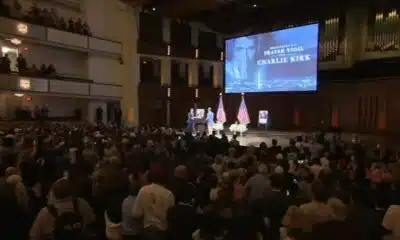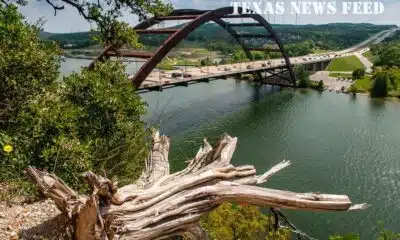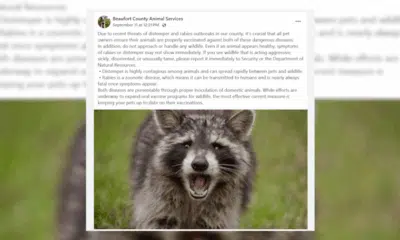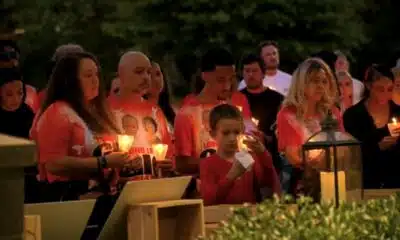News from the South - North Carolina News Feed
When it comes to climate change, are we doomed? It sure looks that way, but we can do something about it • Asheville Watchdog
One of these days, I promise, I’ll spread some Christmas cheer.
But today, my gift is a little, well, doom-ish. Before you fire off an email calling me Scrooge McChristmaskiller, hear me out.
I’m going to recap a fascinating climate discussion held earlier this month, which included high-profile scientists — and a touch of hopeful news. Sure, overall it’s a little bleak, but we have the power to make it less so.
How’s that for a sales pitch?
On Dec. 4, Congregation Beth HaTephila and several other sponsors brought in prominent climate scientist and energy systems analyst Zeke Hausfather, described pre-event as a “world-class, oft quoted climate scientist.” Local climate scientists David Easterling of the National Centers for Environmental Information in Asheville; and Andrew Jones, executive director and cofounder of Climate Interactive in Asheville, also presented to a packed house at The Collider downtown.
To give you a dose of hope early on, I’ll tell you Jones pitched the En-ROADS Climate Solutions Simulator, which is super cool and lets you play around with potential climate solutions and see how much various options can reduce global temperatures. Give it a try.


But here’s the bad news. Hausfather noted that between the 1850s, when reliable global temperature records became available, and the early 1900s, temperatures “went up and down year to year, but there wasn’t really that much of a change.’’
“But since 1970 the earth’s temperature has been rising fairly rapidly,” Hausfather said. “And now, as of 2024, we’re seeing temperatures close to 1.5 degrees (Celsius) above pre-industrial levels.
“And these levels of temperatures, just like levels of CO2, are unprecedented for a very long period in the Earth’s history. So temperatures today are probably higher than we’ve seen for at least 120,000 years, potentially further back than that.”
OK, have a great week. I’m getting on a rocketship for a trip to a reserve Earth-like planet in the Goldilocks zone. I’m pretty sure Elon Musk is moving there, too.
Seriously, Hausfather’s statistics aren’t good, especially when you consider 1.5 degrees Celsius is 2.7 degrees Fahrenheit – and when you consider that about 40 percent of the carbon dioxide we pump into the atmosphere stays there, which means temperatures will likely stay up for a while.
“Certainly, we know that if temperatures stay at today’s levels, they will be there for a century or so,” Hausfather said.
All of this ties in locally because we keep having warmer seasons and we have an increased chance of more devastating storms like Helene, which caused extensive flooding, landslides, and loss of life Sept. 27. We also see more heavy rains in general, as well as droughts that contribute to wildfires out west.
This all comes down to human activity – everything from using coal-burning power plants and factories to driving gas-powered vehicles.
Climate change: We’re the cause of it
I’m always amazed when people don’t believe global warming is real, or they acknowledge it is happening but say there’s no way people are causing it. Hausfather addressed the latter first.

“So I often get a question from people when I’m talking about climate change, of, ‘How could humans really affect the climate? It’s so big.’” Hausfather said. “Planet Earth is so massive, and I think people don’t really understand just how big an impact humans have had in terms of the atmosphere.”
We really like to burn fossil fuels, which emit a lot of carbon dioxide.
“We have burned a mind-numbing amount of carbon,” Hausfather said. “We have burned about 2.6 trillion tons of carbon dioxide since the Industrial Revolution, the vast majority of that in the form of fossil fuels.”
We’re also proficient at removing trees, which consume CO2 and produce oxygen, and that is cooking our own goose, too.
Hausfather put those 2.6 trillion tons of carbon dioxide in perspective.
“That’s roughly the same amount of mass as every living thing on earth, plus everything ever made by humans — the pyramids, all of our roads, all of our buildings combined,” he said. “We have burned that much carbon and put that much carbon dioxide up into the atmosphere, and that’s dramatically changed the composition of our atmosphere.
“Now, about 40 percent of that carbon dioxide has accumulated in the atmosphere, about 1.1 trillion tons. The remainder, thankfully, has been absorbed back into the Earth’s system, primarily into the ocean and into the biosphere.”
That’s good, because climate change “would be twice as bad if the earth weren’t helping clean up some of our mess,” he noted, adding that Earth is getting worse at cleaning up our mess.
Scientists can study tree rings, stalactites, ocean corals and ice cores for information on global temperatures going way back, before recorded history.
I kind of wish they hadn’t.
“We have not seen a period in the Earth’s history where carbon dioxide concentrations have been this high for at least over 3 million years, potentially 4 million,” Hausfather said. “And in the period where it was much higher, the earth’s temperature was much, much hotter than it is today.”
Today, we can measure the effects of our human activities, so it’s not like declaring what’s fueling global warming is speculation.
“This isn’t just supercomputer models that we throw a bunch of fancy equations into,” Hausfather said. “We can measure this. We can measure it by satellites. We can measure it by ground sensors.”
It gets worse, because we’re pumping out other greenhouse gas emissions like methane and nitrous oxide that contribute to warming, as well as aerosols, such as sulfur dioxide emissions, that are essentially suspended particles in the atmosphere.
“These get a lot of press because of their really bad health impacts,” Hausfather said. “Somewhere around 7 million people die each year globally, particularly in Asia, from outdoor air pollution, and most of that is particulate matter that is derived from sulfur dioxide.”
Because sulfur dioxide reflects light back into space, it actually cools the climate, he said, describing “global dimming,” which happens because the sky is so hazy, particularly in Asia.
This is also really bad, because it masks some of the warming we’ve had.
Merry Christmas and Happy Hanukkah! And brace yourself …
We’ve got to clean up the pollution, Hausfather said, which is mostly caused by burning fossil fuels, to solve climate change.
“But this does create a dilemma for us, because as we clean up the air and as we switch away from fossil fuels, a lot of additional warming that we’ve been masking is going to come back to bite us, and that’s a challenge,” Hausfather said.
I’ve got to imagine this guy has single handedly killed more parties than Charles Manson.
The effects on storms like Helene
But hey, we haven’t even gotten to the Helene stuff!
If you warm the planet by one degree Celsius, you get about 7 percent heavier rainfall, the scientist told us.
“Now for tropical cyclones or hurricanes … we see a magnification of somewhere closer to 10 to 15 percent increased rainfall from these intense storms and hurricanes in a warming world,” Hausfather said.
How big an impact this had on Helene is still an area of active scientific research, he noted, although a few early studies have pegged the increased rainfall due to climate change at 10 to 50 percent. It clearly had an effect, though Helene would’ve been catastrophic any way you slice it.
Easterling, who lives in northern Henderson County, pointed out that during Helene and the precipitation a couple days before, his gauge recorded 15 inches of rain.
That exceeded the 1,000-year rainfall amount by about 3 inches. Easterling noted these thresholds for 1,000-year events or 100-year or 500-year events are based on older data, and even an update coming in the next few years is probably going to underestimate future intensity of rainfall.
“The bottom line is, as the atmosphere warms, there’s more moisture in the air, and that (increased) moisture in the air is available to rain out in heavier events,” Easterling said.
It gets a bit worse, as Hausfather noted when he continued.
“The last two years, 2023 and 2024, have been particularly exceptional,” he said, pointing to one of his many charts. “And so we are well above anything we’ve seen previously in the climate, even in the last few decades.”
Scientists aren’t quite sure why.
This year, some parts of the world are going to come in a little bit above 1.5 degrees Celsius from pre-industrial levels, “which is the sort of temperature target the world set itself during the Paris agreement to, ideally, not exceed.” That refers to the 2015 Paris Climate Accords.
“You know, we don’t want to be pushing up against that target already, especially this early,” Hausfather said. “And these big jumps in temperature have really pushed us there.”
The entire planet is on track to breach the 1.5 degree limits in the next decade, perhaps as early as the late 2020s or early 2030s, Hausfather said. The goal from Paris was to limit global warming to well below 2 degrees Celsius and preferably 1.5 degrees.
To do that now, Hausfather said, we’d have to cut global emissions to zero over the next decade.
There is some hope
If you think this talk was dark thus far, keep in mind I’ve left out a fair amount of detail. Even Hausfather acknowledged he could’ve been wearing a black cloak and toting a sickle.
“So that’s kind of the grim side of the talk, but I’m going to leave you guys with a little bit of optimistic things, too, because it’s not all doom and gloom,” Hausfather said.
Global carbon dioxide emissions have flattened over the last decade and the reasons are encouraging.
“A big part of it is that we’ve succeeded in making clean energy cheap,” Hausfather said. “Things like solar energy are the cheapest form of new energy in almost all the world today. The cost of solar batteries have fallen by more than 90 percent over the last decade. Cost of wind (power) has fallen.”

Electric vehicles, bikes, heat pumps, and more have become ubiquitous, especially in China.
“And the world is spending a lot more money on clean energy,” Hausfather said.
Clearly, we cannot become complacent, and we have to do more.
Jones, the Climate Interactive co-founder, had the audience shout out ways we can “bend the curve” — bring those global temperatures down. We all made suggestions for the En-ROADS page. There, you can move slider bars up or down on all kinds of potential ways to help, ranging from curbing deforestation and agricultural emission to boosting energy efficiency and employing more electrification.
Boost renewable energy and cut coal usage, and the increase in global temperature drops.
It’s pretty cool to watch, and the graphics are great. And it showed we can drop the warming.
Buy an electric lawn mower (on my list for the spring), an electric vehicle, or at least a hybrid. Maybe buy an electric bike, or get a more efficient heat pump or refrigerator.
Yes, this night was sobering, and a little depressing. But the situation is not hopeless.
We just can’t keep doing nothing and hoping for the best.
Asheville Watchdog is a nonprofit news team producing stories that matter to Asheville and Buncombe County. John Boyle has been covering Asheville and surrounding communities since the 20th century. You can reach him at (828) 337-0941, or via email at jboyle@avlwatchdog.org. The Watchdog’s local reporting during this crisis is made possible by donations from the community. To show your support for this vital public service go to avlwatchdog.org/support-our-publication/.
Related
The post When it comes to climate change, are we doomed? It sure looks that way, but we can do something about it • Asheville Watchdog appeared first on avlwatchdog.org
News from the South - North Carolina News Feed
White House officials hold prayer vigil for Charlie Kirk
SUMMARY: Republican lawmakers, conservative leaders, and Trump administration officials held a prayer vigil and memorial at the Kennedy Center honoring slain activist Charlie Kirk, founder of Turning Point USA. Kirk was killed in Utah, where memorials continue at Utah Valley University and Turning Point USA’s headquarters. Police say 22-year-old Tyler Robinson turned himself in but has not confessed or cooperated. Robinson’s roommate, his boyfriend who is transitioning, is cooperating with authorities. Investigators are examining messages Robinson allegedly sent on Discord joking about the shooting. Robinson faces charges including aggravated murder, obstruction of justice, and felony firearm discharge.
White House officials and Republican lawmakers gathered at the Kennedy Center at 6 p.m. to hold a prayer vigil in remembrance of conservative activist Charlie Kirk.
https://abc11.com/us-world/
Download: https://abc11.com/apps/
Like us on Facebook: https://www.facebook.com/ABC11/
Instagram: https://www.instagram.com/abc11_wtvd/
Threads: https://www.threads.net/@abc11_wtvd
TIKTOK: https://www.tiktok.com/@abc11_eyewitnessnews
News from the South - North Carolina News Feed
Family, friends hold candlelight vigil in honor of Giovanni Pelletier
SUMMARY: Family and friends held a candlelight vigil in Apex to honor Giovanni Pelletier, a Fuquay Varina High School graduate whose body was found last month in a Florida retention pond. Giovanni went missing while visiting family, after reportedly acting erratically and leaving his cousins’ car. Loved ones remembered his infectious smile, laughter, and loyal friendship, expressing how deeply he impacted their lives. His mother shared the family’s ongoing grief and search for answers as authorities continue investigating his death. Despite the sadness, the community’s support has provided comfort. A celebration of life mass is planned in Apex to further commemorate Giovanni’s memory.
“It’s good to know how loved someone is in their community.”
More: https://abc11.com/post/giovanni-pelletier-family-friends-hold-candlelight-vigil-honor-wake-teen-found-dead-florida/17811995/
Download: https://abc11.com/apps/
Like us on Facebook: https://www.facebook.com/ABC11/
Instagram: https://www.instagram.com/abc11_wtvd/
Threads: https://www.threads.net/@abc11_wtvd
TIKTOK: https://www.tiktok.com/@abc11_eyewitnessnews
News from the South - North Carolina News Feed
NC Courage wins 2-1 against Angel City FC
SUMMARY: The North Carolina Courage defeated Angel City FC 2-1 in Cary, ending their unbeaten streak. Monaca scored early at the 6th minute, followed by Bull City native Brianna Pinto’s goal at the 18th minute, securing a 2-0 halftime lead. Angel City intensified in the second half, scoring in the 88th minute, but the Courage held firm defensively to claim victory. Pinto expressed pride in the win, emphasizing the team’s unity and playoff ambitions. Nearly 8,000 fans attended. Coverage continues tonight at 11, alongside college football updates, including the Tar Heels vs. Richmond game live from Chapel Hill.
Saturday’s win was crucial for the Courage as the regular season starts to wind down.
https://abc11.com/post/north-carolina-courage-wins-2-1-angel-city-fc/17810234/
Download: https://abc11.com/apps/
Like us on Facebook: https://www.facebook.com/ABC11/
Instagram: https://www.instagram.com/abc11_wtvd/
Threads: https://www.threads.net/@abc11_wtvd
TIKTOK: https://www.tiktok.com/@abc11_eyewitnessnews
-
News from the South - Kentucky News Feed7 days ago
Lexington man accused of carjacking, firing gun during police chase faces federal firearm charge
-
News from the South - Alabama News Feed7 days ago
Zaxby's Player of the Week: Dylan Jackson, Vigor WR
-
News from the South - North Carolina News Feed5 days ago
What we know about Charlie Kirk shooting suspect, how he was caught
-
Local News7 days ago
US stocks inch to more records as inflation slows and Oracle soars
-
Local News6 days ago
Russian drone incursion in Poland prompts NATO leaders to take stock of bigger threats
-
News from the South - North Carolina News Feed5 days ago
Federal hate crime charge sought in Charlotte stabbing | North Carolina
-
Local News Video6 days ago
Introducing our WXXV Student Athlete of the Week, St. Patrick’s Parker Talley!
-
The Center Square6 days ago
Weapon recovered as manhunt continues in Kirk assassination investigation | National















































